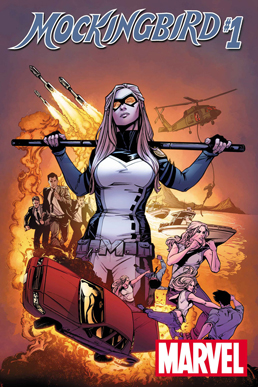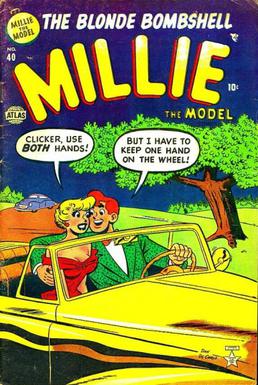
Sheena, Queen of the Jungle, is a fictional American comic book jungle girl heroine, originally published primarily by Fiction House during the Golden Age of Comic Books. She was the first female comic book character with her own title, with her 1941 premiere issue preceding Wonder Woman #1. Sheena inspired a wealth of similar comic book jungle queens. She was predated in literature by Rima, the Jungle Girl, introduced in the 1904 William Henry Hudson novel Green Mansions.

Miss America is a superhero appearing in American comic books published by Marvel Comics. Created by writer Otto Binder and artist Al Gabriele, the character first appeared in Marvel Mystery Comics #49 in the Golden Age of Comic Books. She is the first character to use the moniker Miss America, before America Chavez.

Donald L. Heck was an American comics artist best known for co-creating the Marvel Comics characters Iron Man, the Wasp, Black Widow, Hawkeye and Wonder Man and for his long run penciling the Marvel superhero-team series The Avengers during the 1960s Silver Age of comic books.

Clarence Matthew Baker was an American comic book artist and illustrator, best known for drawing early comics heroines such as the costumed crimefighter Phantom Lady, and romance comics. Active in the 1940s and 1950s Golden Age of comic books, he is one of the first known African-American artists to find success in the comic-book industry. He also penciled St. John Publications' digest-sized "picture novel" It Rhymes with Lust (1950), the first graphic novel despite that term not having been coined at the time.
Werner Roth was an American comic book artist, perhaps best known for immediately succeeding Jack Kirby on Marvel Comics' The X-Men.

Black Widow is a character appearing in American comic books published by Marvel Comics. Created by writer George Kapitan and artist Harry Sahle, she first appeared in Mystic Comics #4, published by Marvel predecessor Timely Comics. Claire Voyant is a medium who has been murdered and became the demonic "ambassador" of Satan on Earth. She kills evildoers in order to deliver their souls to her master.

Barbara "Bobbi" Morse is a fictional superhero appearing in American comic books published by Marvel Comics. The character first appeared in Astonishing Tales #6 in 1971 as a supporting character and eventual love interest of Ka-Zar, with a Ph.D in biology. She is soon revealed to be the highly trained Agent 19 of S.H.I.E.L.D., taking the moniker Huntress in Marvel Super Action #1 in 1976, and Mockingbird in Marvel Team-Up #95 in 1980, before going on to be a member of several Avengers teams, briefly marrying and subsequently divorcing Clint Barton / Hawkeye.

Donato Francisco Rico II was an American paperback novelist, screenwriter, wood engraver and comic book writer-artist, who co-created the Marvel Comics characters the Black Widow with plotter Stan Lee and artist Don Heck; Jann of the Jungle with artist Arthur Peddy; Leopard Girl with artist Al Hartley; and Lorna the Jungle Girl with an artist generally considered to be Werner Roth. His pen names include Dan Rico, Donella St. Michaels, Donna Richards, Joseph Milton, and N. Korok.

Millie the Model was Marvel Comics' longest-running humor title, first published by the company's 1940s predecessor, Timely Comics, and continuing through its 1950s forerunner, Atlas Comics, to 1970s Marvel. The comic book series deals with Millie Collins, an aspiring model.
Jungle Action is the name of two American comic book series published by Marvel Comics and its 1950s precursor, Atlas Comics. The Marvel version contained the first series starring the Black Panther, the first black superhero in mainstream comics, created by the writer/artist team of Stan Lee and Jack Kirby in Fantastic Four #52.

The Blonde Phantom is a fictional masked crime fighter appearing in American comic books published by Marvel Comics. Created for Marvel predecessor Timely Comics by Stan Lee and Syd Shores, the character first appeared in All Select Comics #11, during the 1940s period fans and historians call the Golden Age of Comic Books. The heroine was so well received that the next issue was retitled The Blonde Phantom. The series continued to feature her until issue #22. She also appeared in backup stories in many other Timely comics; in Superhero Comics of the Golden Age, Mike Benton observes that "for a few months in 1948, readers could find her in seven titles on the newsstand." In The Supergirls, Mike Madrid asserted, "Once again, a capable woman hid behind a meek persona and only let her hair down, literally, to come to the aid of a man who completely ignored her unless she assumed a disguise. In a 1947 story entitled "I Hate Myself", Louise even dreams that Mark finally confesses his love for her, only to have the Blonde Phantom persona appear and steal him away."

Betsy Ross is is a character appearing in American comic books published by Marvel Comics. Created by Joe Simon and Jack Kirby, the character first appeared in Captain America Comics #1. Betsy Ross is Captain America's early love interest and supporting character in American comic books published by Marvel Comics during the 1930-1940s period known to historians and collectors as the Golden Age of Comic Books. She then debuted as the superheroine Golden Girl in Captain America Comics #66.

Tarzanesque is a term created by Frenchman Francis Lacassin used to describe characters in comic books inspired by Tarzan. A tarzanesque character resembles Tarzan in his physical resourcefulness, within a line of action that includes an adventurous life in the jungle, the gift of understanding and being understood by animals, contact with lost civilizations and courage combined with the ability to deal with nature. The creation of such characters may have been propitiated by the success that Tarzan had achieved since his appearance in literature in 1912, culminating with the release of daily comic strips in 1929, which paved the way for a genre that combined the allure of the unknown environment, the need for the archetypal characteristics of the hero and the popularity of access.
Characters native to the African continent have been depicted in comics since the beginnings of the modern comic strip. Initially, such early 20th-century newspaper comics as Winsor McCay's Little Nemo depicted the racist stereotype of a spear-carrying cannibal, a comedic convention of the time. African characters later began to appear as another stereotype, the "noble savage" — a similar progression to that of depictions of Native Americans — and eventually as standard human beings.

A jungle girl is an archetype or stock character, often used in popular fiction, of a female adventurer, superhero or even a damsel in distress living in a jungle or rainforest setting. An alternate depiction is a cave girl.
The portrayal of women inAmerican comic books has often been the subject of controversy since the medium's beginning. Critics have noted the roles of women as both supporting characters and lead characters are substantially more subjected to gender stereotypes, with femininity and/or sexual characteristics having a larger presence in their overall character.

Fantomah is an American comics character, best known as one of the earliest comic-book superheroines. Created by Fletcher Hanks, the character first appeared in Jungle Comics #2, published by Fiction House. Hanks is also known for creating the equally strange Stardust the Super Wizard.

Jungle Tales was an American comic book title published by Atlas Comics, the 1950s predecessor to Marvel Comics. It was an anthology title of stories set in an African jungle.

Jay Scott Pike was an American comic book artist and commercial illustrator known for his 1950s and 1960s work for Marvel Comics and DC Comics, advertising art, and as a good girl artist. He created the DC character Dolphin and co-created the Marvel character Jann of the Jungle.
Fran Hopper, née Frances R. Deitrick, was an American comic-book artist active during the 1930s–1940s period known as the Golden Age of Comic Books. One of the earliest women in the field, she drew primarily for the publisher Fiction House on features, including "Jane Martin", "Glory Forbes", "Camilla", "Mysta of the Moon", and "Gale Allen and Her All Girl Squadron".















